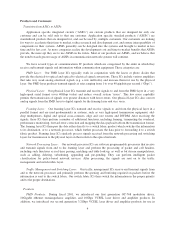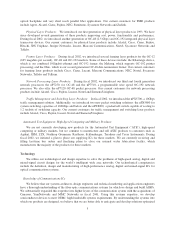3Ware 2002 Annual Report Download - page 19
Download and view the complete annual report
Please find page 19 of the 2002 3Ware annual report below. You can navigate through the pages in the report by either clicking on the pages listed below, or by using the keyword search tool below to find specific information within the annual report.• the ability of our customers to obtain components from their other suppliers;
• the effects of war or acts of terrorism, such as disruptions in general economic activity, changes in
logistics and security arrangements, and reduced customer demand for our products and services; and
• general economic conditions.
Our business, financial condition and operating results would be harmed if we do not achieve anticipated
revenues.
We can have revenue shortfalls for a variety of reasons, including:
• a decrease in demand for our customers’ products;
• a decrease in the financial condition of our customers or liquidity issues with our customers or their
customers;
• a stockpiling of our products by our customers resulting in a reduction in their order patterns as they
work through the excess inventory of our products;
• the reduction, rescheduling or cancellation of customer orders;
• significant pricing pressures that occur because of declines in average selling prices over the life of a
product;
• sudden shortages of raw materials or production capacity constraints that lead our suppliers to allocate
available supplies or capacity to customers with resources greater than us and, in turn, interrupt our
ability to meet our production obligations;
• the pending closure of our internal wafer fabrication facility;
• delays in product availability; and
• fabrication, test or assembly capacity constraints for devices which interrupt our ability to meet our
production obligations.
Our business is characterized by short-term orders and shipment schedules. Customer orders typically can
be canceled or rescheduled without significant penalty to the customer. Because we do not have substantial
noncancellable backlog, we typically plan our production and inventory levels based on internal forecasts of
customer demand which are highly unpredictable and can fluctuate substantially. Our revenues are increasingly
derived from sales of ASSPs, as compared to ASICs. Customer orders for ASSPs typically have shorter lead
times than orders for ASICs, which makes it more difficult for us to predict revenues and inventory levels and
adjust production appropriately. If we are unable to plan inventory and production levels effectively, our
business, financial condition and operating results could be materially harmed.
From time to time, in response to anticipated long lead times to obtain inventory and materials from our
outside suppliers and foundries, we may order materials in advance of anticipated customer demand. This
advance ordering has in the past and may in the future result in excess inventory levels or unanticipated inventory
write-downs if expected orders fail to materialize, or other factors render our products less marketable.
Our expense levels are relatively fixed and are based, in part, on our expectations of future revenues. We
have limited ability to reduce expenses quickly in response to any revenue shortfalls.
The downturn in the communications equipment industry has negatively impacted our revenues and
profitability.
We derive a substantial amount of our revenues from communications equipment manufacturers. The
communications equipment industry, which is highly cyclical, is experiencing a significant extended downturn
14
























